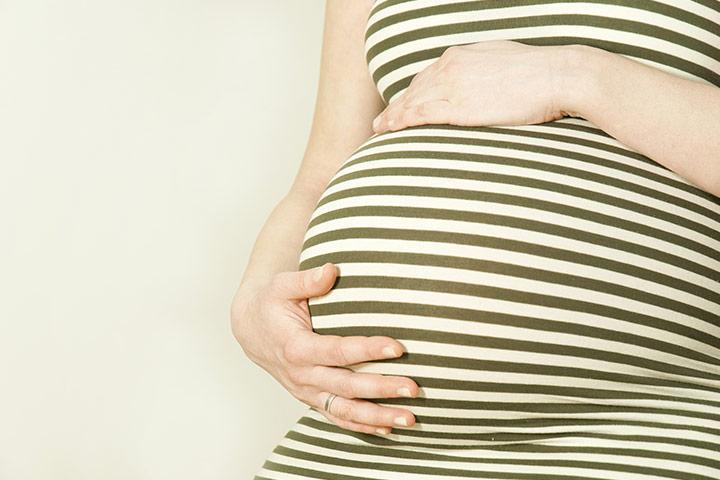
Image: iStock
There are times during natural childbirth or vaginal deliveries when certain situations or complications may require a doctor’s intervention to assist the delivery. Vacuum-assisted delivery is one such method to assist complicated natural deliveries where a baby is pulled out from the birth canal with the help of a vacuum pump.
Read along to know more about vacuum-assisted delivery, its types, procedure, prerequisites, risks, and when to avoid this procedure.
What Is Vacuum-Assisted Delivery?
When the mother is unable to push anymore while delivering the baby, doctors take the help of instrumental delivery, such as a vacuum-assisted vaginal delivery. In this case, a vacuum cup is used to pull out the baby from the birth canal. The vacuum cup, also called the ventouse cup, is a medical equipment made of plastic and attaches to the baby’s head, pulling it out with the help of a vacuum (1).
Why Is Vacuum-Assisted Vaginal Delivery Done?
There may be several reasons why a doctor can suggest assisted mode of delivery with the help of a vacuum cup (2).
- Second stage of labor is progressing slower than expected,
- The mother is unable to push further because she is exhausted or cannot push hard due to some medical conditions.
Danielle LaSusa, a mother and philosophical coach, shares the challenging experience of delivering her baby through vacuum-assisted birth while she was exhausted and battling a fever. She says, “Now, twenty-nine hours after my labor began, it was time for the morning shift change at the hospital. Another OB and nurse came in, and after assessing the situation, she determined that a vacuum assist was needed… The new OB warned me: you only get a few tugs with the vacuum, three or four contractions worth, and if the baby is not out by then, we’d have to go to the OR for a c-section.” Eventually, LaSusa pushed as per the doctors’ guidance and her baby girl was born vaginally (i).
- There are concerns about the neonatal health and safety of the baby, necessitating prompt delivery.
Prior to conducting an assisted delivery, the obstetrician-gynecologist. will take into account several factors, including: (3).
Image: Shutterstock
- Whether the fetus is in the birth canal
- The dilation of the cervix
- The weight of the fetus
What Are The Indicators For A Vacuum-Assisted Delivery?
There are several possible situations under which the doctors recommend going forward with a vacuum-assisted delivery. Some of the common maternal and fetal indicators for this include (4) (5):
Maternal indicators:
- The mother is exhausted, or there is a lack of cooperation
- Insufficient maternal expulsive efforts
- The mother has cardiac or cerebrovascular issues that require her to avoid expulsive efforts
Fetal indicators:
- Non-reassuring heart rate of the fetus
- Failure to progress to the second stage of labor
- The second stage of labor is prolonged
How Is Vacuum-Assisted Delivery Done?
Image: Shutterstock
The procedure for vacuum-assisted delivery is described as follows (6).
- You will be given a local anesthetic injection or an epidural (injection in the back) to block pain during the procedure.
- The vacuum cup is gently placed in a balanced way across the fetus’ scalp.
- Once the cup is successfully placed, the cup’s circumference is checked to avoid the tissues of the vaginal or cervical area from getting confined in between.
- After checking the circumference and the attachment, suction is applied. The pressure of the vacuum extractors is gradually increased. increased from 100 to 150 mm Hg to maintain the cup’s correct position.
- Once the appropriate pressure is reached, pressure is applied along the pelvic curve with the help of two hands to help the process of traction.
- The traction is discontinued when the mother stops pushing at the end of a contraction.
 Point to consider
Point to considerWhat Are The Complications Of A Vacuum-Assisted Delivery?
Fetal morbidity is a notable complication of vacuum-assisted delivery. In addition, it increases the chances of injuries, such as scalp lacerations, intracranial hemorrhageiBleeding into the skull and brain tissue , retinal hemorrhage, and cephalohematomaiCollection of blood under the baby’s scalp due to a birth injury , by 5% more common with the metal cup, and less in silicon or plastic cup (6).
Maternal complications of the procedure can include the following.
- PerinealiArea between the genitals and anus pain during delivery
- Heavy blood loss after delivery
- Stool and urinary incontinenceiA condition characterized by the loss of bladder control
- Hematomas (accumulation of blood outside the blood vessels)
- Vaginal tears or perineal lacerations
- Maternal morbidity
 Things to know
Things to knowVacuum delivery, if done properly, is mostly safe for babies. The only risk that this entails is bleeding under the baby’s scalp, which usually goes away by itself and does not cause any serious problems.
When Is Vacuum-Assisted Delivery Not Recommended?
Vacuum-assisted delivery may not be recommended in the following scenarios.
- The cervix is not fully dilated.
- Cephalopelvic disproportioniA childbirth complication where there is a mismatch between the size of the baby’s head and the mother’s pelvis suspected. .
- The baby’s head is not low enough into the birth canal.
- There is an increased chance of the baby bleeding in the womb.
- The fetus has low bone density.
In such cases, the doctor may soon perform a cesarean delivery to prevent injuries in the mother and the baby.
Image: Shutterstock
Are There Alternatives To Vacuum-Assisted Birth Procedure?
Maternal health and the stage and duration of labor, as well as the health conditions of the baby, determine the potential alternatives to assisted delivery.
The other techniques that are usually considered are:
- Expectant management or watchful waiting of the symptoms
- Stimulating the intensity and frequency of uterine contraction with the help of oxytociniA hormone secreted by the pituitary gland to stimulate contractions during childbirth and lactation
- Emergency cesarean section
Frequently Asked Questions
1. Is vacuum-assisted delivery painful?
You might experience pain in the areas between your vagina and anus after the delivery. The pain and discomfort do not usually last very long.
2. Can vacuum-assisted delivery cause brain damage in babies?
Improperly conducted vacuum-assisted delivery and pre-existing fetal or maternal complications may increase the risk of brain injuries in babies during the procedure.
3. How common is vacuum-assisted delivery?
In the US, around 2.5% vaginal deliveries are vacuum-assisted. However, this mode of delivery is rapidly being replaced by C-section delivery (5).
4. Can vacuum-assisted delivery cause learning disabilities?
Vacuum-assisted delivery increases the risk of intracranial injury that may increase the risk of learning disabilities as the child grows older. However, an injury is less likely if an experienced surgeon conducts the procedure. Also, more research is needed to establish a definitive correlation between vacuum-assisted delivery injuries and learning disabilities in the affected children (7).
5. How long does it take for a baby’s head to become round after vacuum-assisted delivery?
The vacuum extraction may cause the baby’s head to develop swelling, giving them a cone-like appearance. However, this swelling gets resolved in a few days (5).
The process of birth is exciting, tiring, and risky. During this time, some situations might lead to using a vacuum-assisted delivery to ensure your and your baby’s well-being. If done carefully and accurately, it should not cause much harm to either of you. However, if you have any queries or questions about the process, talk to a doctor or healthcare provider.
Infographic: Notable Complications Of Vacuum-Assisted Delivery
Vacuum-assisted delivery, a prevalent medical intervention during childbirth, presents potential risks and complications. This infographic delivers a concise summary of the possible complications associated with the procedure. It equips expectant parents with essential knowledge for informed decision-making and effective management.
Illustration: Momjunction Design Team
Key Pointers
- Vacuum-assisted delivery is considered when the mother has complications during the natural delivery process.
- The process involves using a vacuum cup attached to the baby’s scalp, helping in traction during the baby’s delivery.
- Vacuum-assisted delivery may not be recommended in certain scenarios, such as when the baby’s head is not low enough in the birth canal or cephalopelvic disproportion is suspected.
- It is a safe assisted-delivery process when conducted by an experienced healthcare provider.
Personal Experience: Source
MomJunction articles include first-hand experiences to provide you with better insights through real-life narratives. Here are the sources of personal accounts referenced in this article.
i. No birth plan ever survives contact with the enemy.https://medium.com/@daniellelasusa/no-birth-plan-ever-survives-contact-with-the-enemy-7d5f13445e58
References
- Assisted vaginal birth (ventouse or forceps).
https://www.rcog.org.uk/for-the-public/browse-all-patient-information-leaflets/assisted-vaginal-birth-ventouse-or-forceps/ - Vacuum-assisted delivery.
https://medlineplus.gov/ency/patientinstructions/000514.htm - Assisted Vaginal Delivery.
https://www.acog.org/womens-health/faqs/assisted-vaginal-delivery - Assisted Vaginal Delivery Using the Vacuum Extractor.
https://www.aafp.org/pubs/afp/issues/2000/0915/p1316.html - Vacuum Extraction Delivery.
https://my.clevelandclinic.org/health/treatments/22305-vacuum-extraction-delivery - Unzila A Ali and Errol R Norwitz; (2009); Vacuum-Assisted Vaginal Delivery.
https://www.ncbi.nlm.nih.gov/pmc/articles/PMC2672989/ - Joana Patrícia Meireles and Humberto S Machado; (2018); The Influence of Mode of Delivery on the Neurodevelopment of Children and Adolescents.
https://www.omicsonline.org/open-access/the-influence-of-mode-of-delivery-on-the-neurodevelopment-of-children-and-adolescents-2376-127X-1000378-101760.html
Read full bio of Dr. Evert Pangkahila
Read full bio of Rebecca Malachi
Read full bio of Reshmi Das























